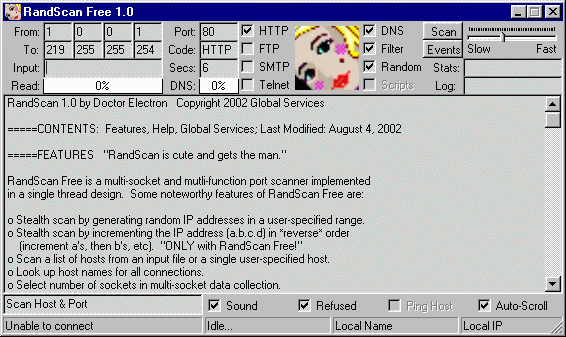
o Stealth scan by generating random IP addresses in a user-specified range.
o Stealth scan by incrementing the IP address (a.b.c.d) in reverse order
(increment a's, then b's, etc). "ONLY with RandScan Free!"
o Scan a list of hosts from an input file or a single user-specified host.
o Look up host names for connected ports.
o Select number of sockets in multi-socket data collection.
o Displays banners -- the self-descriptions -- of connected hosts.
o Gauges show percent hosts with data read and DNS host names.
o Five different logs of results to files for later analysis:
(1) Session data, (2) Found hosts, (3) Transcript, (4) Events, (5) Refused connections.
o ONLY RandScan has a NEW Filter function which may double the speed of finding remote hosts.
Once you click "Scan," say goodbye to the RandScan Girl!
That space is used for a list box of events in your data collection.
Download, run and give her a "mouse touch" to see her message to you.

NEW... Version 1.1 released. Many bugs fixed, enhanced error checking, etc.
The RandScan Girl was so excited, she wanted to put purple lipstick
on her forehead, too, "I feel like party-time."
But Doctor Electron said, "The purple on the cheeks is enough,
not to mention that bright red on the lips."
"Well, OK," RandScan Girl said, "I just wanted people to know that
RandScan Free is now better and has features seldom seen in free software."
Laugh if you want, but the RandScan Girl makes a fortune as Grand Wizard of Marketing.
Get her now. She may not be back soon. My next program will feature an animal.
While we are talking, some of the many uses of RandScan Free are on-topic:
First, system administrators can prepare a list of all of their servers, one for each port. Feed a list file into RandScan and it will tell you what percent of the servers are up and running. The .lst output file documents those servers that are responding. Of course, there are many variations on this theme.
One variation is to scan your network range with "Random" Off. If all of your servers are up and running then RandScan makes a complete list for you in the output .lst file. You can use the Code "All" or something to make that .lst output file unique.
Another variation is to check if servers idendified on a scan on one port are also running services on another port. In this case, the ouput .lst file is used for input into another scan session.
RandScan is designed for serious research and hacking. The PortCode.lst and RandScan.log files may be imported into a spread sheet program like Excel for further sorting and analysis of the data.
The help file is readable at RandScan startup in the central "Transcript" list box. If you want to read the help while you are scanning, just start another instance of the program.
More than one instance of RandScan may be running to work on different data collection jobs. E.g., search for servers can be conducted on two or more different ports. When you do this, keep in mind the total number of sockets that all of the instances of RandScan are using, since this may adversely affect your system performance.
If you need special features for your work, custom copies of the program may be created. Please contact the author.
Back to Net Census